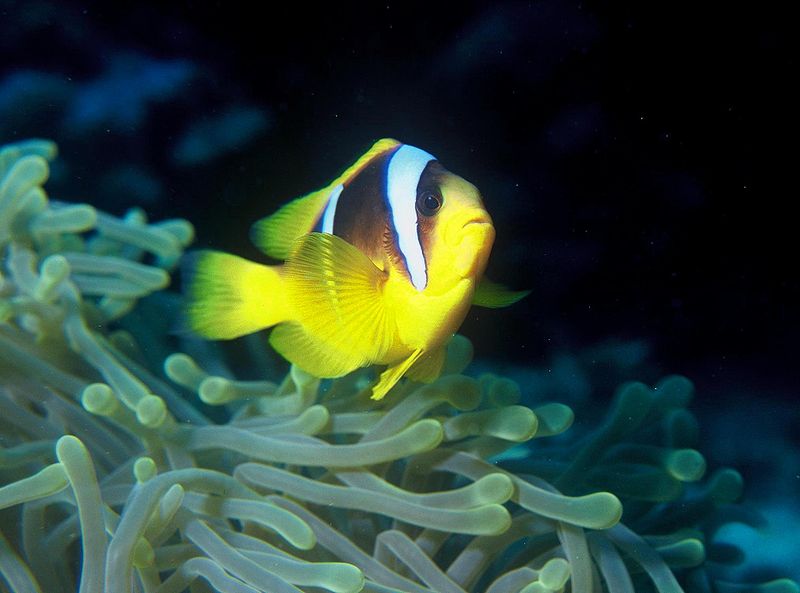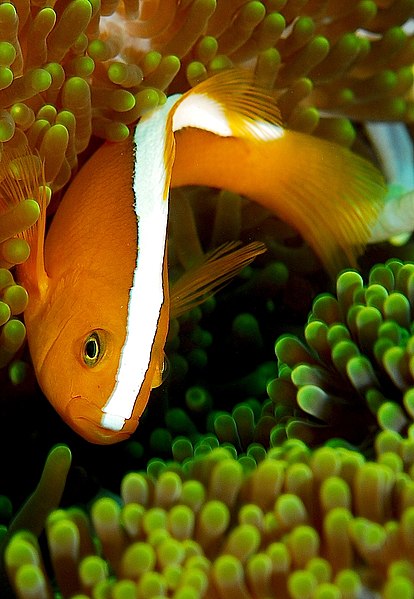Hello, Frank Indiviglio here. Please see Part 1 and Part 2 of this article for general information on Damselfishes and their close cousins, the Clownfishes, and for notes on the care of the beautifully-colored Percula clownfish, Amphiprion percula.
Damselfishes in the Aquarium
 Damselfishes are generally small, brilliantly-colored and in near constant motion. These characteristics, along with their general hardiness, render them quite popular with aquarists.
Damselfishes are generally small, brilliantly-colored and in near constant motion. These characteristics, along with their general hardiness, render them quite popular with aquarists.
Despite their small size, most damselfishes survive quite well in aquariums with larger fishes. However, most are very territorial and rather aggressive towards their own and similar species (please see below).
Taxonomy
Together with the ever-popular clownfishes, the damselfishes are classified in the Family Pomacentridae, which contains over 325 species. Many are superficially similar in appearance but differ greatly in habitat choice, food preferences and other regards, and ichthyologists (fish scientists) describe new species regularly.
Marine Gardeners
 Damselfishes seem inordinately protective of their territories, so much so that these tiny warriors will even attempt to drive off human divers! Research has revealed that several species engage in “aquatic farming, with mated pairs protecting beds of algae, a favored food. Thick mats of algae often grow within well guarded territories but are absent outside these territories, due to a large number of other fishes and invertebrates that feed upon algae.
Damselfishes seem inordinately protective of their territories, so much so that these tiny warriors will even attempt to drive off human divers! Research has revealed that several species engage in “aquatic farming, with mated pairs protecting beds of algae, a favored food. Thick mats of algae often grow within well guarded territories but are absent outside these territories, due to a large number of other fishes and invertebrates that feed upon algae.
The industrious little damselfishes have even been seen to “weed” their algae beds by removing debris and, possibly, competing algae species.
Further Reading
An interesting article on the relationship between Cocoa Damselfishes, human activities, coral reef health and algae is posted here.
I’ll discuss the care of various damselfish species in future articles. Until then, please write in with your questions and comments.
Thanks, until next time,
Frank Indiviglio
 That Fish Blog – Aquarium Advice and Information
That Fish Blog – Aquarium Advice and Information

 Hailing from the Indo-Pacific region (western Pacific and eastern Indian Oceans, including the Great Barrier Reef), this clownfish reaches a length of 3.2 inches in captivity; wild specimens are reported to exceed 4 inches in length, but captive bred animals are generally smaller.
Hailing from the Indo-Pacific region (western Pacific and eastern Indian Oceans, including the Great Barrier Reef), this clownfish reaches a length of 3.2 inches in captivity; wild specimens are reported to exceed 4 inches in length, but captive bred animals are generally smaller. few occur in the Atlantic and Eastern Pacific Oceans. They occupy a startling variety of habitats, with many species restricted to specific depths or specific areas of wave action. Several species can even enter brackish waters.
few occur in the Atlantic and Eastern Pacific Oceans. They occupy a startling variety of habitats, with many species restricted to specific depths or specific areas of wave action. Several species can even enter brackish waters. Anemone tentacles fire their sting-bearing cells (nematocysts) upon contact with any organism that they come in contact with. The tentacles are coated with mucus which inhibits them from stinging one another. It seems that the clownfish secretes mucus which mimics that covering the tentacles of the anemone. Therefore, the anemone simply does not recognize the clownfish as prey, or even as a distinct organism!
Anemone tentacles fire their sting-bearing cells (nematocysts) upon contact with any organism that they come in contact with. The tentacles are coated with mucus which inhibits them from stinging one another. It seems that the clownfish secretes mucus which mimics that covering the tentacles of the anemone. Therefore, the anemone simply does not recognize the clownfish as prey, or even as a distinct organism!